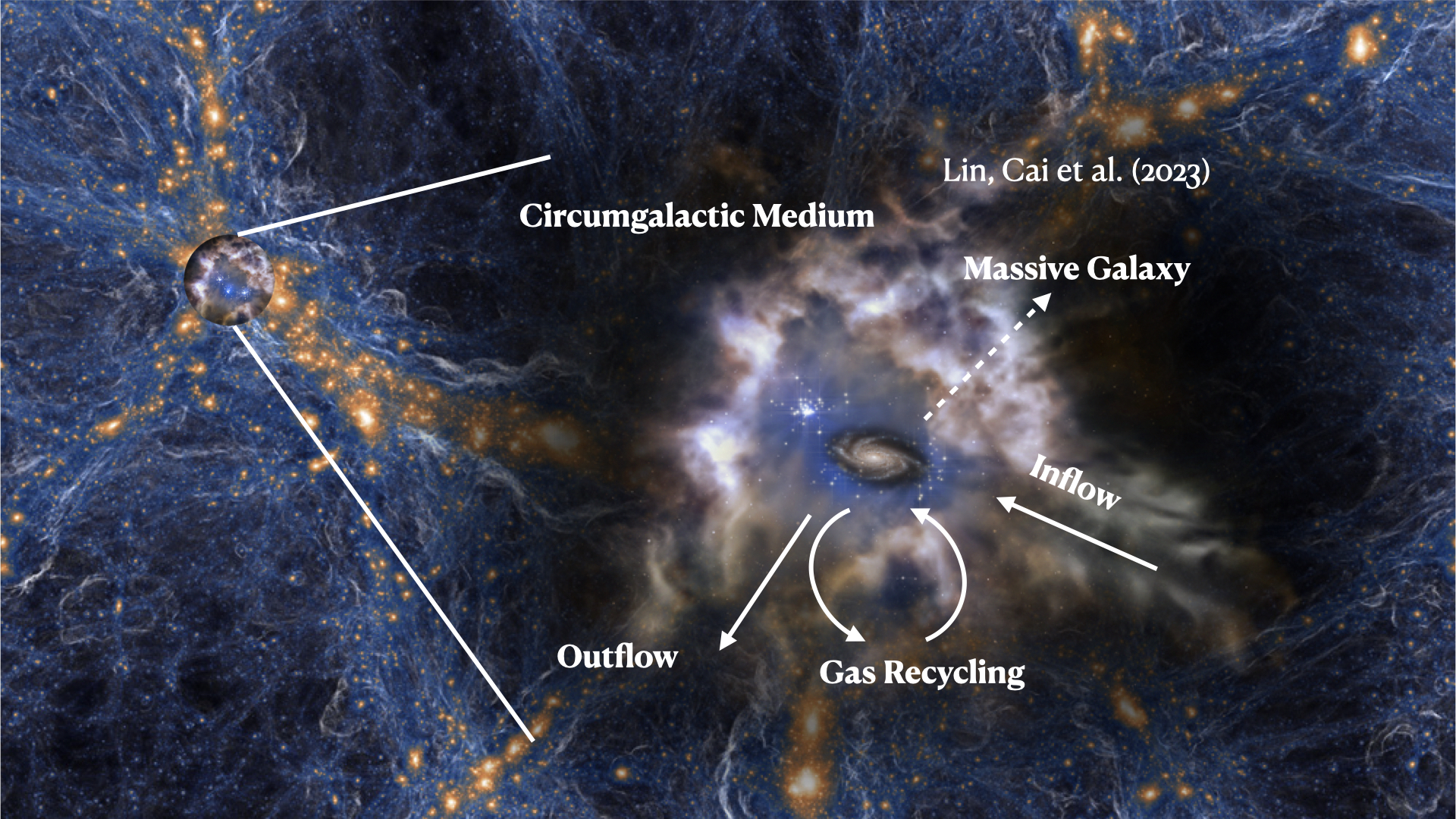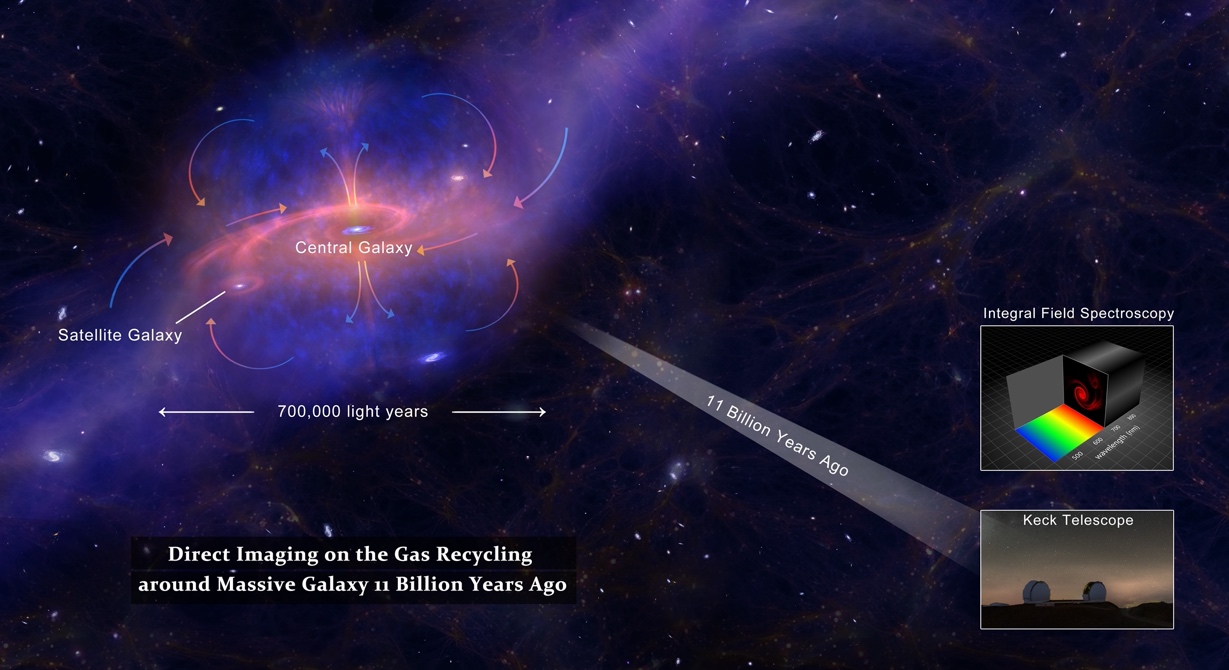
Illustration: Gas Flow Diagram around Galaxies, Tsinghua University
A Tsinghua-led team has generated the first complete picture to show how a massive galaxy feeds on its own expelled gases to create new stars.
Using the most powerful optical telescopes on the ground and in space, researchers from China, the United States, Europe, and Japan observed a huge nebula known as MAMMOTH-1, and found that one of its galaxies was drawing in “inspiraling streams” of surrounding gas, as if drinking through spiral-shaped straws.
The team reported in the journal Science on Friday that materials with a mass of up to 800 suns – all of which were blown out of the galaxy through supernova explosions, solar winds and other violent activities – were sucked back into the galaxy every year.
Lead author Prof. Zheng Cai, from Tsinghua University in Beijing, said much more gas was being pulled in than used to create stars, suggesting star formation could continue long after.
“We estimated the galaxy’s star formation rate to be around 80 solar masses a year, so the recycled gas should provide enough materials to bake all the new stars over a long, long time,” Prof. Cai said.

Illustration: Department of Astronomy, Tsinghua University
Astronomer Bjorn Emonts, from the National Radio Astronomy Observatory in Virginia, said the findings confirmed that the far-off galaxy, whose light takes 11 billion years to reach Earth, did not grow in isolation but evolved with an enormous gas reservoir in which it was embedded.
Emonts, who was not involved in the study, said it was more challenging to detect gas flowing into a galaxy than flowing out.
“The signal emitted by inflowing gas is very weak,” he said.
He also said it was particularly hard to detect the presence of elements heavier than hydrogen and helium, known as “metals”, because of their trace amounts.
Usually, astronomers obtain these faint signals by looking at gas that blocks part of the light from distant background sources. But this only gives information about the gas at the exact location relative to one point, and therefore gives a very incomplete picture.
In the new study, Prof. Cai and his colleagues used state-of-the-art instruments on giant telescopes in Hawaii and low-Earth orbit to directly obtain the elusive emissions of MAMMOTH-1, which allowed them to build an accurate, 3D map of the gas for the first time.
“We were able to obtain the image and spectrum of any location we wanted to measure, and the spectra told us about the composition and kinematics of the gas at those locations,” Prof. Cai said.
The team had two surprising findings. While simulations had shown that the gas should mainly consist of hydrogen left over from the big bang, they discovered an unexpectedly high amount of carbon and other “metal” elements.
“It’s quite shocking to see such metallicity – almost as high as our sun’s – in space outside a galaxy in the early universe,” he said, adding that the metals helped cool the gas so stars could eventually be born at a very low temperature.
The researchers also found that simulations based on their data indicated an enormous amount of the metal-rich gas was flowing into the galaxy rather than out of it as they had expected.
“Our analysis showed that a few satellite galaxies moving around the central galaxy might have played a part, contributing angular momentum to facilitate gas recycling,” Prof. Cai said.
Emonts said the findings supported the predictions of evolutionary processes from computer simulations, but there were still gaps in understanding of galaxies as the ultimate cosmic recyclers.
For instance, the metal-rich gas detected in this study was above 10,000 Kelvin, way too hot for star formation which only happens under 100K. More direct observations were needed to see if cold molecular gas could form before it was deposited back onto the galaxy, he said.
It was also important to investigate if such a recycling mechanism worked for other distant, less massive galaxies.
Prof. Cai said his team at Tsinghua University was leading an effort to raise funding and build a powerful telescope with world-leading ability in spectral survey, which would help scientists detect gas surrounding other galaxies.
The US$200 million, 6.5 metre-diameter telescope, known as MUST, will be located at the Lenghu astronomical observation site in western China’s Gobi Desert and is expected to be completed by 2029. About half of the funding has been raised so far, according to Prof. Cai.
Science paper link: https://www.science.org/doi/10.1126/science.abj9192
Editor: Li Han

